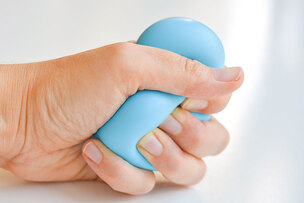 Hand intrinsic strength and coordination are essential for everyday tasks. These muscles help define the arch of the hands, bend the knuckles, and perform opposition of the thumb and fingers. This helps us perform tasks like holding a pencil, manipulating scissor, eating with utensils, brushing our teeth, and writing. One important intrinsic muscle is the lumbricals which have the job of bending our knuckles and extending the smallest joints at the end of our fingers. For example, you may use these muscles to make a hand puppet or to hold a plate. The lumbricals are also used in handwriting to advance the pencil or pen in an upward motion. Our hands need the strength and endurance to be able to correctly perform the upstroke and re-tracing of letters which are required to write the letters a, d, g, h, m, n ,p , q, r, u, v, and w. Most of these motions are developed and perfected as we are younger, but there are many things we can do to help these muscles develop and stay strong. Using hands-on-activates like playing with play dough can help. Rolling the play dough into a ball with one hand, or squeezing play dough with tongs is a great way to strengthen the lumbricals. Another very important group of hand intrinsic muscles are the abductors, flexor pollicis brevis, and the opponens pollicis. These muscles help to rotate the thumb and bring our fingers together for opposition which is used for picking up small items. To work with these muscles we can practice by rolling the play dough into a long log or snake. Hand intrinsic strength is also needed to develop hand eye coordination, cognitive, and sight perception. Being able to position loose part into and over surfaces, cutting the correct piece, and inserting or threading items all use hand eye coordination and sight perception. These skills help us sense our environment, interpret what we are seeing, organize information, and create a visual memory. Play dough can be used to develop hand eye coordination and sight perception when we cut the play dough with scissors, create figures, form letters, or recreate scenes. There are many great ways to encourage the development of the hand intrinsic muscles and play dough is a great tool. Use the recipe below to make you own play dough and make the next playtime a purposeful playtime! Ingredients:
Mix the flour and salt in a large bowl. In a separate bowl mix together the water, a few drops of food coloring and the oil. Pour the colored water into the flour mix and bring together with a spoon. Knead together to form a smooth, pliable dough.  These PT Pro Tips are brought to you by our West Bend physical therapist, Jordan Weyker, PT, DPT. Jordan specializes in women's health, pediatric care, and aquatic therapy. Outside of treating individuals, she enjoys watching her Chicago Cubs play the Brewers in her hometown of Chicago or Milwaukee. Jordan also enjoys traveling, camping, Kayaking, fishing, and traveling back to Haiti whenever she can.
1 Comment
Jeanne Rountree
6/13/2023 06:04:24 pm
Your educational information is very well written but I think you left out that occupational therapist and hand therapist OT/PT can treat the hands, forearms for the details. For OT it’s even more. PT plus patient and occupational therapist.
Reply
Leave a Reply. |
Archives
March 2024
Categories |
|
Central phone: 262-796-2850
Central fax: 262-796-2851 Central email: patientcare@ptplus.com Website by RyTech, LLC
|
|
